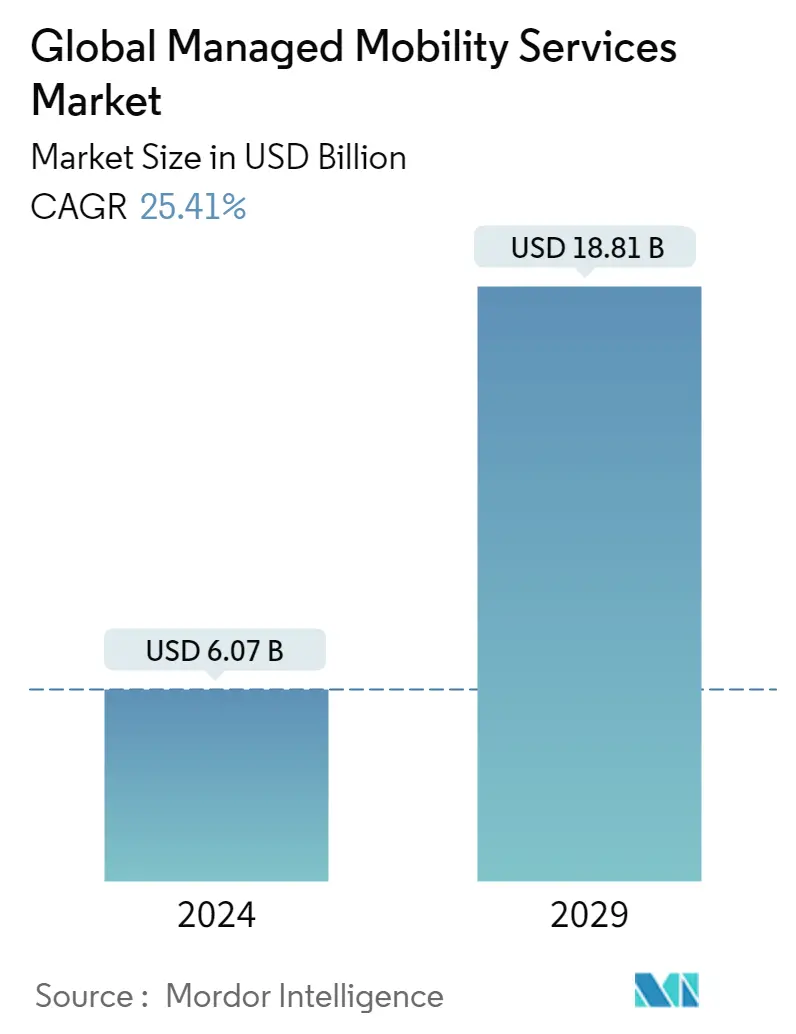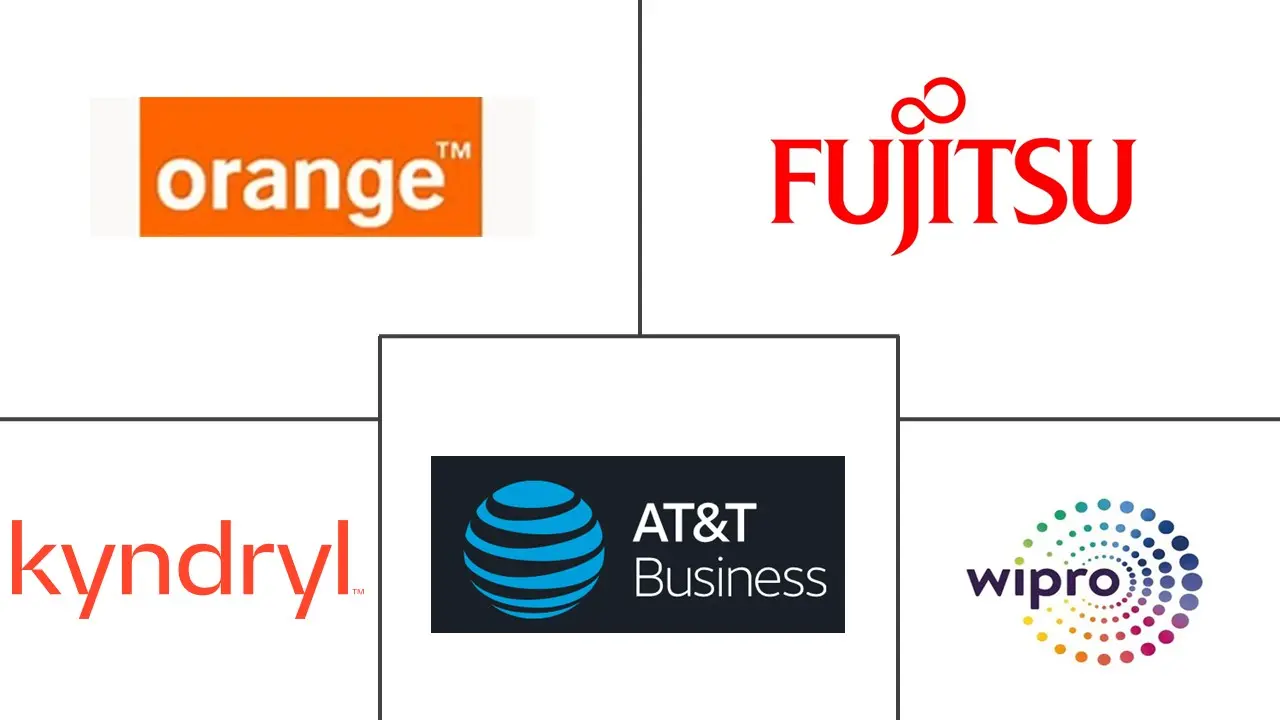Market Size of Global Managed Mobility Services Industry

| Study Period | 2019 - 2029 |
| Market Size (2024) | USD 6.07 Billion |
| Market Size (2029) | USD 18.81 Billion |
| CAGR (2024 - 2029) | 25.41 % |
| Fastest Growing Market | Asia Pacific |
| Largest Market | North America |
Major Players
*Disclaimer: Major Players sorted in no particular order |
Managed Mobility Services Market Analysis
The Global Managed Mobility Services Market size is estimated at USD 6.07 billion in 2024, and is expected to reach USD 18.81 billion by 2029, growing at a CAGR of 25.41% during the forecast period (2024-2029).
- The managed mobility service providers offer solutions that ease the burden on enterprise IT departments by dealing with complex managing of various device platforms, with the help of interpreted content for specialized mobile applications. Therefore, managed mobility services enable easy communication with mobile office workers by connecting them with management, servers, and databases. Thus, it allows enterprises to overcome the traditional communications that involve PC only for business emails, databases, and other corporate content.
- Furthermore, mobility as a service solution simplifies corporate personnel's complex mobile device technology needs by offering a single partner to manage the whole mobile device lifecycle. Thus, these companies take the hassle of managing mobile technology so that IT teams can save resources and time to focus on the strategic initiatives that are helping them to transform their businesses.
- The growing shift of mature organizations toward digital connectivity drives at least 50% of employees to use more than one device for work that demands centralized management. Thus, the rise of new types of carrier devices continues to flood workplaces and expand the mobility ecosystem, driving the need for experienced MMS providers to handle the complexity of communication across organizations.
- The use of mobile devices among doctors, nurses, patients, and other supporting staff has increased worldwide. Moreover, organizations in the healthcare end-user industry must adhere to HIPAA regulations for data sharing and storage. These factors are expected to drive the adoption of managed mobility services in the healthcare industry.
- Customers are still witnessing challenges for cost visibility as they invest in the third-party managed mobility service. Some vendors lack the expertise to estimate the total costs or the capacity or resources in order to add individual parameters to arrive at an estimated cost manually. Such challenges add a drawback to the market.
- Overall, the impact of COVID-19 on the global managed mobility services market has been mixed. While the pandemic has increased demand for MMS services due to the shift toward remote work, it has also caused disruptions to supply chains and economic uncertainties, leading to a decrease in investment in some cases. However, the pandemic has also accelerated technological advancements in the global MMS market, leading to new and innovative solutions. The market for MMS services is expected to grow in the long term as companies look for ways to increase efficiency and adapt to changing business environments.
Managed Mobility Services Industry Segmentation
Managed mobility services (MMS) are defined as the procurement, deployment, and management of mobile devices and apps and PC software and services, connecting out-of-office workers to the enterprise environment. The options for allied services range from short-term post-go-live assistance to long-term application operations. Managed mobility services (MMS) market for the study defines the revenues generated from functions such as mobile device management, mobile application management, mobile security, and other functions that are being used in various end-user industries worldwide. The scope of the study is limited only to the services offered in the market for mobility management. The study also analyses the overall impact of COVID-19 on the ecosystem. The study includes qualitative coverage of the most adopted strategies and an analysis of the key base indicators in emerging markets.
The managed mobility services market is segmented by function (mobile device management, mobile application management, mobile security), deployment (cloud and on-premise), end-user industry (IT and telecom, BFSI, healthcare, manufacturing, retail, education), and geography (North America (United States and Canada), Europe (United Kingdom, Germany, France, Rest of Europe), Asia-Pacific (China, India, Japan, and the rest of Asia-Pacific), Latin America (Brazil, Argentina, Mexico, and the rest of Latin America), Middle East and Africa (United Arab Emirates, Saudi Arabia, South Africa, and the rest of Middle East and Africa)). The market sizes and forecasts are provided in terms of value in USD million for all the above segments.
| By Function | |
| Mobile Device Management | |
| Mobile Application Management | |
| Mobile Security | |
| Other Functions |
| By Deployment | |
| Cloud | |
| On-premise |
| By End-user Industry | |
| IT and Telecom | |
| BFSI | |
| Healthcare | |
| Manufacturing | |
| Retail | |
| Education | |
| Other End-user Industries |
| By Geography | ||||||
| ||||||
| ||||||
| ||||||
| ||||||
|
Global Managed Mobility Services Market Size Summary
The managed mobility services market is poised for significant growth, driven by the increasing complexity of mobile device management and the need for centralized solutions in enterprises. As organizations shift towards digital connectivity, the demand for managed mobility services is rising, particularly in sectors like healthcare, where compliance with regulations such as HIPAA is crucial. These services alleviate the burden on IT departments by managing the entire mobile device lifecycle, allowing companies to focus on strategic initiatives. The proliferation of mobile devices in the workplace, coupled with the adoption of bring-your-own-device (BYOD) policies, further fuels the need for streamlined mobility services. The market is also influenced by the growing mobile subscriber base in emerging economies, which enhances work efficiency and flexibility.
The impact of COVID-19 has been mixed, with increased demand for managed mobility services due to the shift to remote work, but also disruptions and economic uncertainties affecting investments. However, the pandemic has accelerated technological advancements, leading to innovative solutions in the market. The rise of IoT solutions and the deployment of 5G technology are expected to drive further growth, as they offer smart communication environments and enhanced connectivity. Cybersecurity concerns and regulatory requirements also play a significant role in the market's expansion, as enterprises prioritize IT security amidst increasing data breach costs. The market is characterized by fragmentation, with major players like AT&T, Fujitsu, Kyndryl Inc., Wipro, and Orange SA adopting strategies such as partnerships and innovations to gain a competitive edge.
Global Managed Mobility Services Market Size - Table of Contents
-
1. MARKET INSIGHTS
-
1.1 Market Overview
-
1.2 Industry Attractiveness - Porter's Five Forces Analysis
-
1.2.1 Bargaining Power of Suppliers
-
1.2.2 Bargaining Power of Buyers/Consumers
-
1.2.3 Threat of New Entrants
-
1.2.4 Intensity of Competitive Rivalry
-
1.2.5 Threat of Substitute Products
-
-
1.3 Assessment of COVID-19 Impact on the Market
-
-
2. MARKET SEGMENTATION
-
2.1 By Function
-
2.1.1 Mobile Device Management
-
2.1.2 Mobile Application Management
-
2.1.3 Mobile Security
-
2.1.4 Other Functions
-
-
2.2 By Deployment
-
2.2.1 Cloud
-
2.2.2 On-premise
-
-
2.3 By End-user Industry
-
2.3.1 IT and Telecom
-
2.3.2 BFSI
-
2.3.3 Healthcare
-
2.3.4 Manufacturing
-
2.3.5 Retail
-
2.3.6 Education
-
2.3.7 Other End-user Industries
-
-
2.4 By Geography
-
2.4.1 North America
-
2.4.1.1 United States
-
2.4.1.2 Canada
-
-
2.4.2 Europe
-
2.4.2.1 United Kingdom
-
2.4.2.2 Germany
-
2.4.2.3 France
-
2.4.2.4 Rest of Europe
-
-
2.4.3 Asia-Pacific
-
2.4.3.1 China
-
2.4.3.2 India
-
2.4.3.3 Japan
-
2.4.3.4 Rest of Asia-Pacific
-
-
2.4.4 Latin America
-
2.4.4.1 Brazil
-
2.4.4.2 Argentina
-
2.4.4.3 Mexico
-
2.4.4.4 Rest of Latin America
-
-
2.4.5 Middle East and Africa
-
2.4.5.1 United Arab Emirates
-
2.4.5.2 Saudi Arabia
-
2.4.5.3 South Africa
-
2.4.5.4 Rest of Middle East and Africa
-
-
-
Global Managed Mobility Services Market Size FAQs
How big is the Global Managed Mobility Services Market?
The Global Managed Mobility Services Market size is expected to reach USD 6.07 billion in 2024 and grow at a CAGR of 25.41% to reach USD 18.81 billion by 2029.
What is the current Global Managed Mobility Services Market size?
In 2024, the Global Managed Mobility Services Market size is expected to reach USD 6.07 billion.

